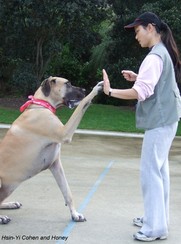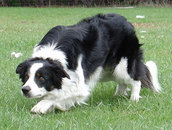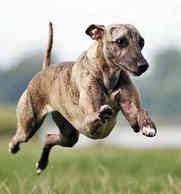Read the breed: How to customise training for specific breeds

Dog breeds often come with a long list of supposed traits, which usually include things like "easy to train" or "requires a firm hand", "good with kids", "protective of their family" and so on.
Many of these supposed breed traits have nothing much to do with the breed, but are influenced by the specific dog's temperament as well as how well they were socialised, and with what method they were trained. Most assessments with regards to ease of training are based on traditional training techniques, ie the use of aversives such as choke chains, pushing into position, and growling/stern voice when the dog does the "wrong" thing.
As a result, sighthounds never get off the leash because they can't be trained to come back anyway, chows and malamutes feel the whole swag of punishments available to keep them "at the bottom of the pack", and collies don't get to see many kids early in life because they are supposedly "naturally good with kids".
The results of this ill informed approach can range from stir crazy whippets and aggressive malamutes to fearful collies.
None of this is inevitable of course. Good positive reinforcement training instills fast and reliable recalls in sighthounds and good manners in chows and malamutes, and carefully orchestrated socialisation ensures that Lassie does indeed enjoy the presence of children.
If we look past these interpreted traits, and concentrate on the traits inherent to the purpose of the breed, we find many aspects that are relevant for training, eg the herding instinct in sheepdogs, chasing of fleeing prey in sighthounds etc. Working dog breeds still possess enormous physical and mental energy, but when kept as pets often end up chronically understimulated, creating many training problems.
A good trainer will take the breed specific traits of a dog into account, as well as his personality.
Below are some guidelines for some well known breeds. For more information, contact DeltaDogz.
Many of these supposed breed traits have nothing much to do with the breed, but are influenced by the specific dog's temperament as well as how well they were socialised, and with what method they were trained. Most assessments with regards to ease of training are based on traditional training techniques, ie the use of aversives such as choke chains, pushing into position, and growling/stern voice when the dog does the "wrong" thing.
As a result, sighthounds never get off the leash because they can't be trained to come back anyway, chows and malamutes feel the whole swag of punishments available to keep them "at the bottom of the pack", and collies don't get to see many kids early in life because they are supposedly "naturally good with kids".
The results of this ill informed approach can range from stir crazy whippets and aggressive malamutes to fearful collies.
None of this is inevitable of course. Good positive reinforcement training instills fast and reliable recalls in sighthounds and good manners in chows and malamutes, and carefully orchestrated socialisation ensures that Lassie does indeed enjoy the presence of children.
If we look past these interpreted traits, and concentrate on the traits inherent to the purpose of the breed, we find many aspects that are relevant for training, eg the herding instinct in sheepdogs, chasing of fleeing prey in sighthounds etc. Working dog breeds still possess enormous physical and mental energy, but when kept as pets often end up chronically understimulated, creating many training problems.
A good trainer will take the breed specific traits of a dog into account, as well as his personality.
Below are some guidelines for some well known breeds. For more information, contact DeltaDogz.
Border Collies, Kelpies and other herding dogs

In my first dog breed book from 30 odd years ago, Border Collies were classified as working dogs unsuitable to city living. This is probably still as true now as it was then: a great many of the dogs at the RSPCA are Border Collies, Kelpies and their cross breeds, because they just end up being too hard to manage for the average owner in a city environment. They need an enormous amount of mental stimulation beyond the basics of training, as well as tons of exercise, but at dog-runs-free pace, which no human can offer for long on a leash.
Border Collies and Kelpies positively blossom when trained by positive reinforcement. Just watch Mary Ray to see what they are capable of apart from expertly herding sheep.
Here are some tips when training this breed. For more information, contact DeltaDogz.
Border Collies and Kelpies positively blossom when trained by positive reinforcement. Just watch Mary Ray to see what they are capable of apart from expertly herding sheep.
Here are some tips when training this breed. For more information, contact DeltaDogz.
- Clicker training sits very well with these breeds, as they are not only smart, but also very specific, so they enjoy getting exact feedback about what they are doing.
- When initially training a recall, make yourself an interesting target by moving around quickly, or running away, this will get the dog's attention and bring him to you faster.
- In a city environment, many of these dogs become ball obsessed, as chasing the ball is the closest they get to herding sheep. It is enticing to throw the ball a lot as an easy way to exercise the dog. However this can easily backfire in several ways: Border Collies can become very protective of their ball, and attack other dogs trying to play with them or take the ball away; and running after the ball becomes obsessive, to the point where the dog is unable to socialise with other dogs or execute any other behaviour.
- Instead of throwing the ball all the time, use it more sparingly as a powerful reinforcer. Ask for other behaviours before you throw the ball as a reward. You'll be surprised how quickly and efficiently your dog will execute whatever it is you want (provided of course you have trained it what to do), just so it can get the ball!
- Consider training tricks. It's fun particularly in combination with the clicker, and it will give your dog something to use its brain. For great ideas, have a look at "Dog Tricks" by Mary Ray.
- If your dog shows tendencies to "herd" or chase cars, bikes or kids, start on desensitising / counter-conditioning as soon as the problem appears. Once their instinct fully kicks in, it will be much harder to train them out of it. Ideally start interrupting any herding/chasing attempt by a recall when they are very young puppies: Let your puppy take a few steps towards a moving target, and straight away do your most enticing recall, followed by very nice treats. Repeat, repeat, repeat. Then let it take a few more steps towards the target. Soon you should see the puppy turning towards you when it sets eyes on a car/bike/child - yippee! Reward, and keep rewarding very frequently. This is incredibly valuable impulse control in these breeds, and should never be taken for granted.
- Consider joining a dog club (make sure they use positive methods) to take part in Flyball and Agility. Dogs of these breeds just love these sports, and it's great fun for you too.
- Here's a link to an article with more advice on how to channel the energy of these fabulous dogs.
Sighthounds (Whippets, Greyhounds, Afghans ...)

Commonly this group of dogs has been labeled as hard to train. Afghans have even been labelled the most stupid breed, along with the Beagle.
Dogs of these breeds simply do not respond well at all to coercion of any kind, and tend to shut down when treated harshly, which to them includes a harsh voice. Thus, they seem "dumb" or not interested in training. One traditionally "trained" whippet I met started shivering the moment the command "sit" was uttered. Teaching the sit the traditional way includes pushing the dogs backside down, as well as giving them an upwards yank on the choke chain in case they resist. The owner of said whippet stated that it "doesn't want to sit on its bony bottom." Needless to say, this whippet also had no intention of coming back when called.
Yet, most dogs of these breeds are extremely food motivated. With a positive reinforcement approach, they are an absolute delight to train. Kiara, my own whippet, is a point in case. Clicker trained from 8 weeks, she can never get enough of training. She would probably happily learn new things to do all day if I could spare the time.
Here's an inspirational website of a trainer of adopted greyhounds. Using positive reinforcement training, she trains them to do just about anything to top standard. She picks greyhounds with HIGH prey drive, as they are easier to train! So much for prey drive standing "in the way" of obedience. If you know how to harness this drive, it will very much work in your favour.
Afghans, incidentally, are the main subjects of the "Really Reliable Recall" DVD by Leslie Nelson, a long time dog trainer who has developed a well thought out way of teaching a reliable recall, particularly to sighthounds. Using positive reinforcement methods, she has trained two of her Afghans to the Utility Dog title.
Here are some training tips for Sighthounds. For more information, contact DeltaDogz.
Dogs of these breeds simply do not respond well at all to coercion of any kind, and tend to shut down when treated harshly, which to them includes a harsh voice. Thus, they seem "dumb" or not interested in training. One traditionally "trained" whippet I met started shivering the moment the command "sit" was uttered. Teaching the sit the traditional way includes pushing the dogs backside down, as well as giving them an upwards yank on the choke chain in case they resist. The owner of said whippet stated that it "doesn't want to sit on its bony bottom." Needless to say, this whippet also had no intention of coming back when called.
Yet, most dogs of these breeds are extremely food motivated. With a positive reinforcement approach, they are an absolute delight to train. Kiara, my own whippet, is a point in case. Clicker trained from 8 weeks, she can never get enough of training. She would probably happily learn new things to do all day if I could spare the time.
Here's an inspirational website of a trainer of adopted greyhounds. Using positive reinforcement training, she trains them to do just about anything to top standard. She picks greyhounds with HIGH prey drive, as they are easier to train! So much for prey drive standing "in the way" of obedience. If you know how to harness this drive, it will very much work in your favour.
Afghans, incidentally, are the main subjects of the "Really Reliable Recall" DVD by Leslie Nelson, a long time dog trainer who has developed a well thought out way of teaching a reliable recall, particularly to sighthounds. Using positive reinforcement methods, she has trained two of her Afghans to the Utility Dog title.
Here are some training tips for Sighthounds. For more information, contact DeltaDogz.
- Never ever be rough with your sighthound, particularly a puppy.
- As with herding dogs, start interrupting their instinct to chase at a very early age with an emphatic recall (which you would have trained at home), and as soon as they have laid eyes on the potential target (such as a duck or a magpie). Reward heavily - really - when they respond and come back to you. Very gradually let them go after their "prey" a little longer, and recall, rewarding heavily. After a few months, you can let them have a go at chasing, after you have done an initial recall. This will strengthen their response, as they have a way to get the "fun" activity they wanted, after they have done what you asked them (this is called the "Premack principle"). You might find them not going through with the chase, but stopping and looking at you instead! Yippee, call them back, reward them, and let them go again. (Obviously if you want to actually race your sighthound, this is not a good idea, but these training tips are written for pet owners, not racing dog owners).
- Having a good recall in place means you can give your sighthound the exercise they need. They may be "couch potatoes" at home, but they do need very vigorous unfettered exercise to remain sane, particularly when they are still young. Once your dog is out of his mind from lack of exercise and socialisation, any training, and particularly the recall, will become unreliable.
- Unfortunately, many Australian States, including Victoria, have incredibly restrictive laws for Greyhounds. Greyhounds are never allowed off leash - by law, even if it has always been a pet! Also any Greyhound must be muzzled in public, unless they have come through the GAP program. For more information, see this fact sheet by the Greyhound Adoption Program. I am appalled at this unfair treatment of these beautiful dogs.
